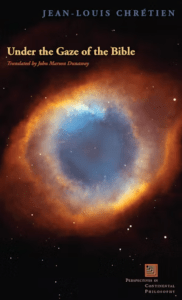We support our Publishers and Content Creators. You can view this story on their website by CLICKING HERE.
St. Gregory the Great once observed that we would all immediately read a letter sent to us by an earthly emperor, but most of us ignore the Scriptures even though they are personally addressed to us by the divine emperor. What kind of response, though, is due to the Scriptures?
Under the Gaze of the Bible by Jean-Louis Chrétien (144 pages, Fordham University Press, 2014)
 You probably receive many emails per day. Many of them demand some sort of response, and some require an urgent one. They are essentially electronic knocks on your door, demanding your time and attention. I like letters much more. A letter demands a response, but it is not just a burden as an email so often is. Rather, a letter is both a task and a gift. It is a gift of the presence of a loved one and a task to respond appropriately.
You probably receive many emails per day. Many of them demand some sort of response, and some require an urgent one. They are essentially electronic knocks on your door, demanding your time and attention. I like letters much more. A letter demands a response, but it is not just a burden as an email so often is. Rather, a letter is both a task and a gift. It is a gift of the presence of a loved one and a task to respond appropriately.
If you receive a letter from a dear friend, you will probably read it as soon as you can. If the letter is from someone important, you will probably do likewise. St. Gregory the Great once observed that we would all immediately read a letter sent to us by an earthly emperor, but most of us ignore the Scriptures even though they are personally addressed to us by the divine emperor.
What kind of response, though, is due to the Scriptures? The French philosopher Jean-Louis Chrétien’s Under the Gaze of the Bible is an attempt to help us respond fittingly to the Scriptures insofar as they are God’s words addressed personally to me and to you.
Under the Gaze of the Bible is composed of eight lectures and articles by Chrétien. They all have slightly different audiences, but they all share the goal of approaching the active, creative, challenging, and demanding sacred text of the Scriptures with proper reverence. Chrétien probes for the proper posture before the Word. Proposing two postures, he asks, “When it is a matter of the Word of God, in fact, is the goal (supposing it possible otherwise than in illusory fashion) to master it or to let oneself be mastered by it?” (10).
This first posture is to focus on mastering the text. By understanding the structure, concepts, context, language, and history of the Scriptures, we understand revelation more fully. In this way, we offer our intellects to be formed by God as we investigate and interrogate the Scriptures. We use them as a privileged instrument to learn about ourselves, the world, and God.
The second posture is to let oneself be mastered. For Chrétien, this is absolutely essential. The best way to read Scripture is to let it read you. Being mastered by Scripture means approaching the sacred text as living, effective, and authoritative. The words should have a claim not only on your intellect but on every aspect of your life.
Chrétien sees the first posture as essential to reading the Scriptures well. We must strive to understand the text and master its concepts, language, and structure. Nevertheless, he points to the primacy of the second posture. Chrétien insists that in the presence of the Word of God, “it is not a matter of giving it the pitiful offering of an instant of our attention but of making the offering of our being, so that it may lead us back to our being in all its truth” (10). As the primary author is God himself, we cannot offer only our minds to God who created us in our entirety. Merely giving our assent is not enough. Rather, we must offer our entire being, body and soul, thought and action. Reading the Scriptures, then, is an all-embracing sacrificial enterprise. Like Abraham, the Word of God is calling us to offer to God what is dearest to ourselves. If we do so, like Abraham, we will not be put to shame.
✠
Republished with gracious permission from Dominicana (June 2024).
The Imaginative Conservative applies the principle of appreciation to the discussion of culture and politics—we approach dialogue with magnanimity rather than with mere civility. Will you help us remain a refreshing oasis in the increasingly contentious arena of modern discourse? Please consider donating now.
The featured image is Saint Jerome Writing (between 1605 and 1606) by Caravaggio, and is in the public domain, courtesy of Wikimedia Commons.
Share This Story, Choose Your Platform!
Go to Top

 Conservative
Conservative  Search
Search Trending
Trending Current News
Current News 






